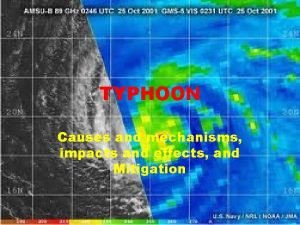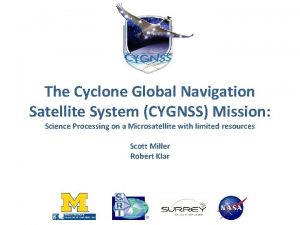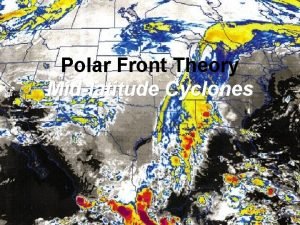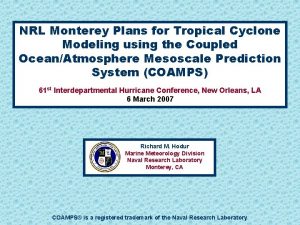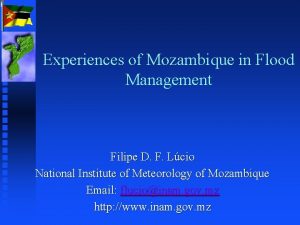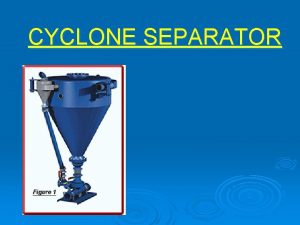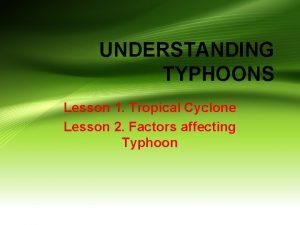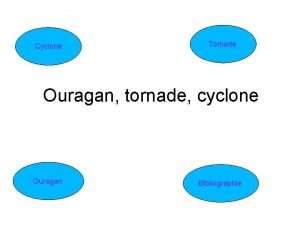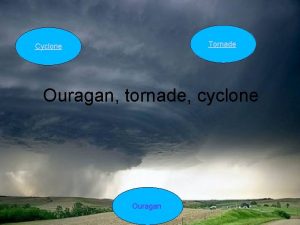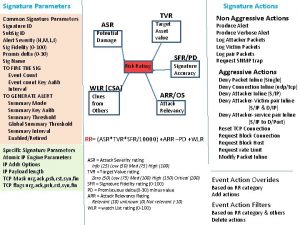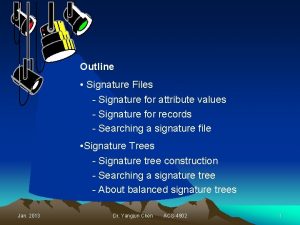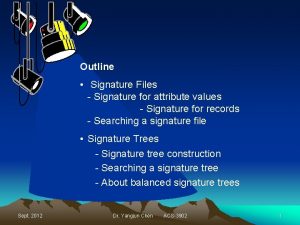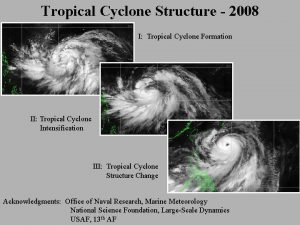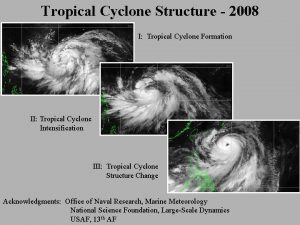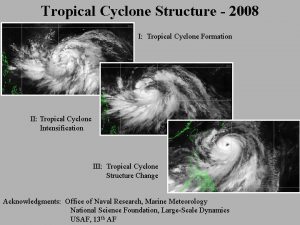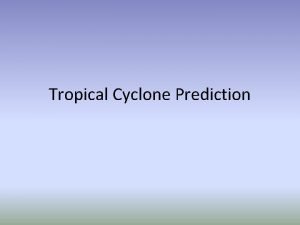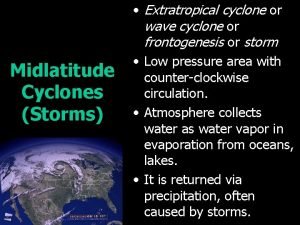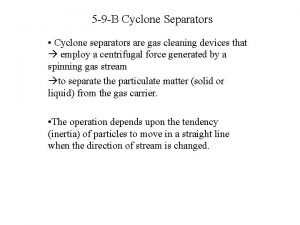Cyclone Phase Classification Worksheet Moisture Structure TPW signature





















- Slides: 21


Cyclone Phase Classification Worksheet

Moisture Structure - TPW signature - Utilize CIMSS TPW product Find maximum value - Measure to threshold value - Threshold = Min + 0. 75*(Max – Min) - Min value w/in 600 km radius Moisture Structure (TPW) – Value : 58. 0 mm @ Latitude: 20. 15 N Longitude: 139. 79 E Theta : 90 Symmetry : 1. 444 Max Width : 1200. 0 km -- 25 -205 axis Min Width : 831. 0 km -- 115 -295 axis TPW Type : Symmetric Moist

Surface Wind Field – Symmetry of Wind Field - Utilize CIMSS Convergence as proxy Find maximum value - Measure to threshold value - Threshold = 0. 75*(Max) - 800 km analysis radius - May also use SSMI imagery for symmetry Could also use new ADT 2 D wind product Low Level Structure (Convergence) – Value : 14. 0 x 10^-6 s^-1 @ Latitude: 21. 01 N Longitude: 142. 24 E Theta : 110 Symmetry : 1. 404 Max Width : 363. 2 km -- 55 -235 axis Min Width : 258. 7 km -- 165 -345 axis Symmetry : Symmetric

Surface Wind Field – Radius of Maximum Winds - Utilize Two RMW values Could also use radial measurements for symmetry value - Multiplatorm Tropical Cyclone Surface Wind Analysis (MTCSWA) product obtained via NOAA/NESDIS (developed by CSU/CIRA) Also can utilize wind information from ATCF CARQ file obtained from NHC or JTWC ARCHER? - NSOF_201704300600_17 S_FIX Surface Wind Field – MTCSWA Analysis Date: 20170430 Time: 060000 Z Latitude: 13. 9 S Longitude: 122. 1 E NE/SE/SW/NW: 35/40/40/0 Symmetry of Wind Field: 1. 87 Nearly Symmetric (1. 5 -2. 0) Radius of Maximum Winds: 35 km CARQ Report Date: 20170430 Time: 000000 Z Latitude: 13. 4 S Longitude: 122. 1 E NE/SE/SW/NW: 20/55/65/25 Symmetry of Wind Field: 1. 06 Symmetric (less than 1. 5) Radius of Maximum Winds: 35 km

850 mb Vorticity - Utilize CIMSS 850 mb Vorticity product Find maximum value - Measure to threshold value - Threshold = 25. 0 - 800 km analysis radius 850 mb Vorticity – Value : 67. 0 x 10^-6 s^-1 @ Latitude: 19. 00 N Longitude: 138. 17 E Theta : 80 Symmetry : 1. 652 Max Width : 522. 6 km -- 35 -215 axis Min Width : 316. 4 km -- 115 -295 axis Magnitude : Moderate Symmetry : Near-Symmetric

Convective Structure – Size of Conv. Envelope - Utilize IR imagery Provides estimate of size and symmetry of storm convection (similar to CDO analysis in ADT) Find minimum temperature value - Measure to threshold value - Threshold = 0. 75*(Min) - 500 km analysis radius - Working on Deep Convection Structure using SSMI Deep Convection (IR) – Value : -57. 0 C @ Latitude: 16. 41 S Longitude: 95. 77 E Theta : 100 Symmetry : 1. 303 Max Width : 141. 2 km -- 165 -345 axis Min Width : 108. 4 km -- 65 -245 axis

Vertical Wind Shear - Utilize CIMSS Wind Shear product Find value at storm center point Could also use CIMSS shear emails Vertical Wind Shear – Value : 15. 0 m/s @ Latitude: 22. 195312 N Longitude: 138. 172 E Classification : Moderate

Sea Surface Temperature - Utilize NOAA/NESDIS SST analysis Find value at storm center point Sea Surface Temperature – Value : 27. 1 C @ Latitude: 22. 195312 N Longitude: 138. 172 E

Baroclinicity - Obtain GFS model data from NCEP Determine 1000— 500 mb thickness in four directions related to center point (NE, NW, SE, SW) @ +/- 3 degrees Determine gradient along two “spokes” (NW->SE and NE->SW) Working on graphical display of this product. Could just display existing GFS 1000 -500 mb thickness plot from existing website. Baroclinic Analysis – Date: 20170428 Time: 120000 Z Latitude: 22. 195312 N Longitude: 138. 172 E NW-->SE gradient: -91. 5120 h. Pa NE-->SW gradient: -35. 4400 h. Pa Classification: Moderate Temperature Gradient Hybrid - Possible Subtropical

Core Temperature Anomaly - Utilize CIMSS AMSU product Find anomaly values at storm center point in four AMSU channels Anomaly = Average temperature on 50 km wide (500 -550 km from center) annulus minus center temperature value AMSU – Date: 20170428 Time: 114200 Z Latitude: 22. 20 N Longitude: 138. 17 E Channel 8 Anomaly: 0. 53 C (~100 mb/15. 8 km) Channel 7 Anomaly: -0. 02 C (~200 mb/11. 8 km) Channel 6 Anomaly: 0. 37 C (~350 mb/8. 1 km) Channel 5 Anomaly: 0. 69 C (~500 mb/5. 6 km) Scene Type: Subtropical Cyclone warm anomaly near tropopause with cold core near surface

JTWC Low-Medium-High Worksheet

Low Level Structure - Symmetry - Utilize CIMSS Convergence as proxy Find maximum value - Measure to threshold value - Threshold = 0. 75*(Max) - 800 km analysis radius - May also use SSMI imagery for symmetry Could also use new ADT 2 D wind product Low Level Structure (Convergence) – Value : 14. 0 x 10^-6 s^-1 @ Latitude: 21. 01 N Longitude: 142. 24 E Theta : 110 Symmetry : 1. 404 Max Width : 363. 2 km -- 55 -235 axis Min Width : 258. 7 km -- 165 -345 axis Symmetry : Symmetric

Low Level Structure – Symmetry - Use radial measurements for symmetry value - Multiplatorm Tropical Cyclone Surface Wind Analysis (MTCSWA) product obtained via NOAA/NESDIS (developed by CSU/CIRA) Also can utilize wind information from ATCF CARQ file obtained from NHC or JTWC - NSOF_201704300600_17 S_FIX Surface Wind Field – MTCSWA Analysis Date: 20170430 Time: 060000 Z Latitude: 13. 9 S Longitude: 122. 1 E NE/SE/SW/NW: 35/40/40/0 Symmetry of Wind Field: 1. 87 Nearly Symmetric (1. 5 -2. 0) Radius of Maximum Winds: 35 km CARQ Report Date: 20170430 Time: 000000 Z Latitude: 13. 4 S Longitude: 122. 1 E NE/SE/SW/NW: 20/55/65/25 Symmetry of Wind Field: 1. 06 Symmetric (less than 1. 5) Radius of Maximum Winds: 35 km

Low Level Structure – 850 mb Vorticity - Utilize CIMSS 850 mb Vorticity product Find maximum value - Measure to threshold value - Threshold = 25. 0 - 800 km analysis radius 850 mb Vorticity – Value : 67. 0 x 10^-6 s^-1 @ Latitude: 19. 00 N Longitude: 138. 17 E Theta : 80 Symmetry : 1. 652 Max Width : 522. 6 km -- 35 -215 axis Min Width : 316. 4 km -- 115 -295 axis Magnitude : Moderate Symmetry : Near-Symmetric

Dvorak Fix Values - Utilize TAFB and SAB Dvorak Analysis Add ADT and SATCON in near future? Dvorak – PGTW: T 1. 0 (T 1. 5/2. 0/W 2. 0/24 HRS/S 0. 0/03 HRS) 30/0850 Z @ Latitude: 13. 31 S Longitude: 121. 82 E KNES: T 1. 0 (T 1. 0/2. 0/W 2. 0/24 HRS) 30/0530 Z @ Latitude: 13. 4 S Longitude: 121. 9 E

Model Development not examined yet

MJO Status – OLR anomaly - Utilize NOAA Uninterpolated OLR data from Earth System Research Lab Find value at storm center point Compute difference between daily value and mean value Outgoing Longwave Radiation (OLR) – Daily Value : 239. 4 W/m^2 on Date : 2017/04/26 Mean Value : 258. 9 W/m^2 (from 1979 -1995) Departure : -19. 5 W/m^2 @ Latitude : 22. 20 N Longitude : -138. 17 E

Vertical Wind Shear - Utilize CIMSS Wind Shear product Find value at storm center point Use CIMSS shear email info? Vertical Wind Shear – Value : 15. 0 m/s @ Latitude: 22. 195312 N Longitude: 138. 172 E Classification : Moderate

Upper Level Outflow – Outflow Pattern - - Utilize CIMSS Divergence as proxy Find maximum value - Measure to threshold value - Threshold = MIN(17. 5, 0. 75*(Max)) - 800 km analysis radius Also determine outflow channels by looking at pattern in divergence field and identifying maximum extent regions - Threshold = MIN(7. 5, 0. 75*(Max)) Upper Level Structure (Divergence) – Value : 22. 0 x 10^-6 s^-1 @ Latitude: 22. 88 N Longitude: 142. 63 E Theta : 60 Symmetry : 1. 613 Max Width : 745. 8 km -- 55 -235 axis Min Width : 462. 5 km -- 115 -295 axis Outflow Channel Type : Dual Outflow Channel Direction : Multi-Directional TC Intensification : 35 kts/6 hr

Where things currently stand - Currently have several products to examine in development suite - Need to fine tune current suite to mimic JTWC analysis for each individual product - Also need to further investigate additional products (e. g. ADT 2 D wind field) for use with current product suite or to replace products that are not sufficient (e. g. Convergence analysis for surface wind fields) Next Steps - Must determine if other products currently missing (e. g. Model Development and other model based products) can be automated - Once all products are automated and working correctly (mimicking JTWC analysis), the final combined assessment of Phase or Low-Medium-High using all related products must be performed.
 Information retrieval data structures and algorithms
Information retrieval data structures and algorithms Normal phase vs reverse phase chromatography
Normal phase vs reverse phase chromatography Tswett pronunciation
Tswett pronunciation Mobile phase and stationary phase
Mobile phase and stationary phase What is mobile and stationary phase
What is mobile and stationary phase Normal phase vs reverse phase chromatography
Normal phase vs reverse phase chromatography Difference between phase voltage and line voltage
Difference between phase voltage and line voltage Hplc detector types
Hplc detector types In a triangle connected source feeding a y connected load
In a triangle connected source feeding a y connected load Csce 441
Csce 441 Cause and effect paragraph about typhoon
Cause and effect paragraph about typhoon Cyclone global navigation satellite system
Cyclone global navigation satellite system Describe in brief the various methods of size separation
Describe in brief the various methods of size separation Polar front
Polar front Nrl monterey
Nrl monterey What is mechanical operation
What is mechanical operation Occluded front cross section
Occluded front cross section Filipe d
Filipe d Cyclone chemical engineering
Cyclone chemical engineering Cyclone programming language
Cyclone programming language Typhoons
Typhoons Skc aluminum cyclone
Skc aluminum cyclone










